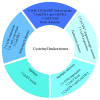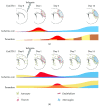Cysteinyl Leukotrienes as Potential Pharmacological Targets for Cerebral Diseases
- PMID: 28607533
- PMCID: PMC5451784
- DOI: 10.1155/2017/3454212
Cysteinyl Leukotrienes as Potential Pharmacological Targets for Cerebral Diseases
Abstract
Cysteinyl leukotrienes (CysLTs) are potent lipid mediators widely known for their actions in asthma and in allergic rhinitis. Accumulating data highlights their involvement in a broader range of inflammation-associated diseases such as cancer, atopic dermatitis, rheumatoid arthritis, and cardiovascular diseases. The reported elevated levels of CysLTs in acute and chronic brain lesions, the association between the genetic polymorphisms in the LTs biosynthesis pathways and the risk of cerebral pathological events, and the evidence from animal models link also CysLTs and brain diseases. This review will give an overview of how far research has gone into the evaluation of the role of CysLTs in the most prevalent neurodegenerative disorders (ischemia, Alzheimer's and Parkinson's diseases, multiple sclerosis/experimental autoimmune encephalomyelitis, and epilepsy) in order to understand the underlying mechanism by which they might be central in the disease progression.
Figures


Similar articles
-
Cysteinyl Leukotrienes and Their Receptors: Emerging Therapeutic Targets in Central Nervous System Disorders.CNS Neurosci Ther. 2016 Dec;22(12):943-951. doi: 10.1111/cns.12596. Epub 2016 Aug 19. CNS Neurosci Ther. 2016. PMID: 27542570 Free PMC article. Review.
-
Role of the Cysteinyl Leukotrienes in the Pathogenesis and Progression of Cardiovascular Diseases.Mediators Inflamm. 2017;2017:2432958. doi: 10.1155/2017/2432958. Epub 2017 Aug 28. Mediators Inflamm. 2017. PMID: 28932020 Free PMC article. Review.
-
A novel therapeutic potential of cysteinyl leukotrienes and their receptors modulation in the neurological complications associated with Alzheimer's disease.Eur J Pharmacol. 2019 Jan 5;842:208-220. doi: 10.1016/j.ejphar.2018.10.040. Epub 2018 Oct 30. Eur J Pharmacol. 2019. PMID: 30389631 Review.
-
5-lipoxygenase pathway and its downstream cysteinyl leukotrienes as potential therapeutic targets for Alzheimer's disease.Brain Behav Immun. 2020 Aug;88:844-855. doi: 10.1016/j.bbi.2020.03.022. Epub 2020 Mar 25. Brain Behav Immun. 2020. PMID: 32222525 Review.
-
The role of leukotrienes in allergic diseases.Allergol Int. 2015 Jan;64(1):17-26. doi: 10.1016/j.alit.2014.09.001. Epub 2014 Nov 22. Allergol Int. 2015. PMID: 25572555 Review.
Cited by
-
Microglia depletion diminishes key elements of the leukotriene pathway in the brain of Alzheimer's Disease mice.Acta Neuropathol Commun. 2020 Aug 8;8(1):129. doi: 10.1186/s40478-020-00989-4. Acta Neuropathol Commun. 2020. PMID: 32771067 Free PMC article.
-
Interaction between α-Synuclein and Bioactive Lipids: Neurodegeneration, Disease Biomarkers and Emerging Therapies.Metabolites. 2024 Jun 22;14(7):352. doi: 10.3390/metabo14070352. Metabolites. 2024. PMID: 39057675 Free PMC article. Review.
-
Longitudinal assessment of peripheral organ metabolism and the gut microbiota in an APP/PS1 transgenic mouse model of Alzheimer's disease.Neural Regen Res. 2025 Oct 1;20(10):2982-2997. doi: 10.4103/NRR.NRR-D-23-01979. Epub 2024 Jun 26. Neural Regen Res. 2025. PMID: 39610107 Free PMC article.
-
Leukotriene signaling in neurodegeneration: implications for treatment strategies.Inflammopharmacology. 2024 Dec;32(6):3571-3584. doi: 10.1007/s10787-024-01557-1. Epub 2024 Aug 21. Inflammopharmacology. 2024. PMID: 39167313 Review.
-
Ergolide Regulates Microglial Activation and Inflammatory-Mediated Dysfunction: A Role for the Cysteinyl Leukotriene Pathway.Int J Mol Sci. 2025 May 23;26(11):5050. doi: 10.3390/ijms26115050. Int J Mol Sci. 2025. PMID: 40507859 Free PMC article.
References
Publication types
MeSH terms
Substances
LinkOut - more resources
Full Text Sources
Other Literature Sources

